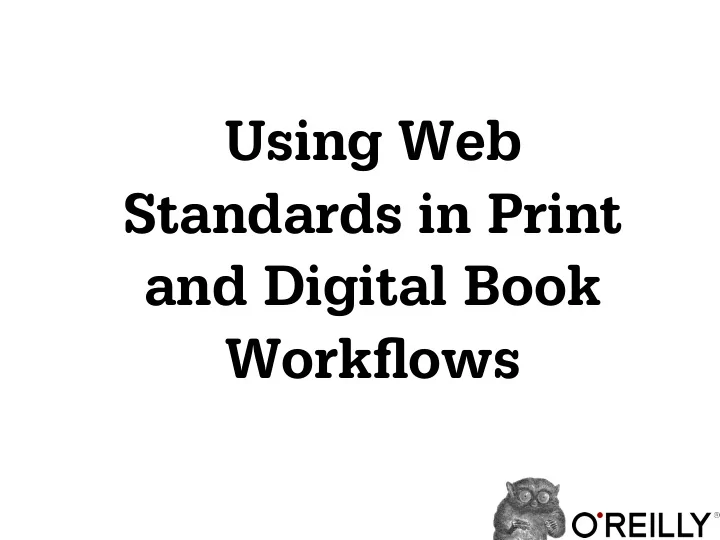

Using Web Standards in Print and Digital Book Workflows
A Story in Four Chapters Chapter 1. Escape from FrameMaker Chapter 2. Down the Cascade Chapter 3. Dawn of HTMLBook Chapter 4. Atlas Never Shrugs
Chapter 1. Escape from FrameMaker
FrameMaker to DocBook XML
Why? • Safari Books Online • Needed Unicode support • Digital books were coming
XSLT AH XML XSL-FO
So What? Book ≠ PDF
Book ?
Chapter 2. Down the Cascade
Culminating Events • EPUB 3 • O’Reilly loses lead XSL-FO developer • Antenna House 6.0 with CSS support
HTML5 XSLT AH XML + CSS
Building Pages with CSS • Key modules: Paged Media, Generated Content, Text, Fonts • A few vendor extensions
Paged Lorem ipsum... Media Lorem ipsum... Lorem ipsum... Lorem... @bottom-right
Generated Content @page chaptermaster:right { /* right page setup */ @bottom-right { /* recto run foot */ content: string(Section)"\2003\007C\2003"counter(page); font-family: "MyriadPro"; font-size: 9pt; vertical-align: top; padding-top: 0.05in; font-weight: 600; color: cmyk(0%,0%,0%,100%); } }
Result
Vendor Extensions? Typography Image Placement -ah-hyphenate-hyphenated-word -ah- fl oat: auto-next top wrap page; -ah-kerning-mode: pair; -ah- fl oat-margin-y: 0 12pt; -ah-over fl ow-condense: font-size; -ah- fl oat- fl oat-margin-y: 0 8pt; -ah-ignore-leading-newline -ah-avoid-widow-words -ah-suppress-duplicate-page- number
Benefits of CSS over XSL-FO • “Democratization” of style sheet development • Removes programmer from between designer and page • Faster development
Benefits of CSS over Traditional Page Layout • Flexibility • Separates content from presentation
O’Reilly “Animal” Book Template 3,251 lines of CSS • Tables • Code examples • MathML • Figures • Index • Table of Contents • Sidebars • Glossary • Front matter • Notes • Bibliography
Limitations • Dependency on commercial PDF processors for professional-quality books • Complex layouts and two-page spreads can be difficult • Limited ability to style right and left pages distinctly
@page :left { @page :right { aside { aside { border-radius: 0 10pt 10pt 0 ; border-radius: 10pt 0 0 10pt; } } } }
Moving Ahead • Publishers need to use CSS and provide feedback • Support for newer modules: Exclusions, Regions, Grid Layout
Chapter 3. Dawn of HTMLBook
DocBook
HTML HTML DocBook HTML HTML
Why Do We Need DocBook?
Benefits of Using HTML “Natively” • Simplifies or outright eliminates the document transformation layers • Potentially aligns our toolset with other things happening on the Web
Lessons of DocBook • Most authors want nothing to do with XML • DocBook had a valuable community • A single-source content model is incredibly valuable - Able to regenerate digital books of entire corpus in hours - Able to easily adapt to new digital book formats
HTMLBook http://github.com/oreillymedia/HTMLBook
What Is HTMLBook? • HTMLBook is a subset of XHTML5. All HTMLBook is HTML5, but not all HTML5 is HTMLBook. • HTMLBook is semantically tailored to the structure of a book. • HTMLBook is defined with and can be validated against an XML schema.
Do Publishers Really Need a Schema?
How Do You Describe the Parts of the Book?
class vs. data-* <section class="chapter"> <h1>Rise of HTMLBook</h1> .... <section data-*="chapter"> <h1>Rise of HTMLBook</h1> ....
W3C on Custom Data Attribute A custom data attribute is an attribute in no namespace whose name starts with the string " data- ", has at least one character after the hyphen, is XML-compatible, and contains no uppercase ASCII letters. ... Custom data attributes are intended to store custom data private to the page or application, for which there are no more appropriate attributes or elements. These attributes are not intended for use by software that is independent of the site that uses the attributes. http://www.w3.org/html/wg/drafts/html/master/dom.html#custom-data-attribute
The Problem with @class <section class=" chapter green-border "> <h1>Rise of HTMLBook</h1> .... <section class=" chapter afterword "> <h1>Rise of HTMLBook</h1> ....
data-type (following epub:type )
Ongoing Work • Scripting to optimize output for PDF, EPUB 2.1 and 3.0, and Mobi (much of which will be available in GitHub) • Porting PDF, EPUB, and Mobi stylesheets to HTMLBook • Markdown/AsciiDoc to HTMLBook transformation tools
Use It! Fork It!
Chapter 4. Atlas Never Shrugs
Using Git with Atlas 1. Author clones down book project to local writing environment 2. Author writes in HTML, Markdown, or AsciiDoc and pushes files back to Atlas 3. Atlas transforms files to HTMLBook and builds book formats
Interactivity with Fallbacks
atlas.labs.oreilly.com
Le Fin
Recommend
More recommend